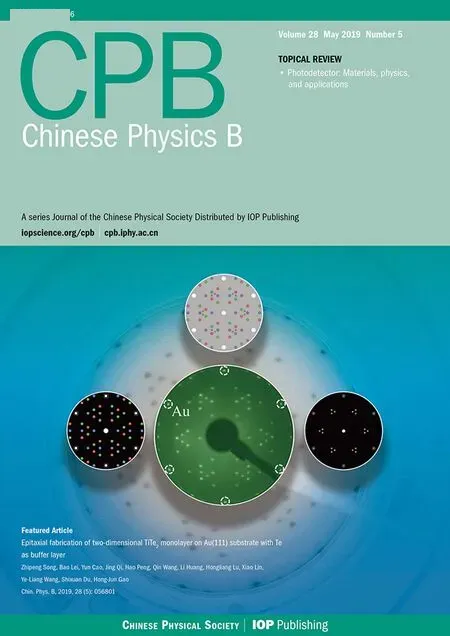Raman scattering study ofmagnetic layered M PS3 crystals(M=M n,Fe,Ni)*
Yi-MengWang(王藝朦),Jian-Feng Zhang(張建豐),Cheng-He Li(李承賀),Xiao-LiMa(馬肖莉),Jian-Ting Ji(籍建葶),Feng Jin(金峰),He-Chang Lei(雷和暢),Kai Liu(劉凱),
Wei-Lu Zhang(張瑋璐)3,and Qing-M ing Zhang(張清明)2,4,?
1DepartmentofPhysics,Renm in University ofChina,Beijing 100872,China
2Beijing National Laboratory forCondensed MatterPhysics,Institute ofPhysics,Chinese Academy ofSciences,Beijing 100190,China
3DepartmentofEngineering and Applied Sciences,Sophia University,7-1 Kioi-cho,Chiyoda-ku,Tokyo 102-8554,Japan
4SchoolofPhysicalScience and Technology,Lanzhou University,Lanzhou 730000,China
(Received 12 February 2019;revisedmanuscript received 16March 2019;published online8 April2019)
Keywords:Raman scattering,two-dimensionalmagnetic van der Waalsmaterials,lattice dynam ics,mag netism
1.Introduction
One of the current research interests in two-dimensional(2D)materials focuses on magnetic van der Waals(vdW)materials,due to the intriguing physical properties for both fundamental research and potential applications in optoelectronics,spintronics,and valleytronics. A number of potentially magnetic single-layer vdW materials have recently been proposed,including V-based dichalcogenides,CrGeTe3ternary tritellurides,and CrX3trihalides.Studies on CrI3reveal that it has a stable ferromagnetic(FM)ordering in 2D form and a little change of layer-number dependence of Curie temperatures.[1–5]This hasattracted a lotof attention in other magnetic vdW crystals thatare similar to CrI3.[6–12]
Recently,many studieshave focused on themagnetic van derWaalscrystals M P X3,which resemblesim ilar latticestructure and chem ical composition.[13–16]M P X3is a fam ily of 2D vdW layered crystals that have been prepared and studied for two decades.The structure of bulk M PS3is similar to CrI3which adopts themonoclinic A lCl3structure(pointgroup C2h).The layer structure isanchored by(P2X6)4-bipyram ids in a triangular latticewhich provide enclosures for transition metal(TM)atoms arranged in a hexagonal array.[17–23]The monolayer M PS3has a perfect honeycomb lattice similar to graphene.Formagnetism in M PS3,the intralayermagnetic structuresareantiferromagnetic(AF).However,depending on thevariety of TM atoms,magnetic structurespossessvery rich types.ForMnPS3material,the AF phase transition temperature TNis 78 K.Themagneticmoment is 3.5μB[23]and the spin lies in the ab plane with inclined angle.Themagnetic structure of MnPS3in the ab plane is N′eel AF in which the spin of the two adjacentmagnetic ions is reversed and the magnetism along the c-axis is FM ordering.For FePS3,its TNis 120 K and the spinmoment is along the c-axis.In the ab plane,themagnetic structure is zigzag-type AF ordering in which the two adjacentmagnetic ionsare the same and are opposite to the third neighbor.A long the c-axis,themagnetic order is AF type.For NiPS3,its TNis 150 K and the angle between the spin and the c-axis is less than 30°.The intralayer magnetic structure of NiPS3is zigzag-typewhich is the same as FePS3,while the interlayermagnetic order is FM type.[10]
Raman is a useful tool to study the structure and magnetic properties of ultrathin vdW single crystals.Meanwhile,thereare severalspectroscopic studies in FePS3and NiPS3.In the previous studies of thin layer FePS3and NiPS3,two different point groups,C2hand D3d,have been proposed when discussing the phonon modes and the lattice structure.[13,14]However,no consensushasyetbeen reached.The information on MnPS3is still lacking.A comparative study of the phonon spectra in M PS3(M=Mn,Fe,Ni)is important for the clarif ication of this issue.Moreover,the temperature dependence behaviorsofmagnetism in M PS3havenotbeen studied ordiscussed in detail.Therefore,thiscalls forasystematic research of the phonon spectra andmagnetic properties in M PS3materialswith different transitionmetals.
In this paper,we present temperature-dependent and polarization-resolved Raman spectroscopy study on layered M PS3(M=Mn,Fe,Ni)single crystals.Almost all of the Raman active phonons are observed,and the phonon mode assignments aremade by symmetry analysis and comparison with f irst principle calculations.In particular,we conduct a comparative study of Raman spectra in MnPS3,FePS3,and NiPS3,which share identical lattice structure butexhibit distinctmagnetic order,and their temperature evolution crosses themagnetic transition.Consequently,we provide comprehensive information on the relation of the latticedynamicsand magnetism in the M PS3system.
2.Experimentaland calculationmethods
Single crystals of M PS3(M=Mn,Fe,Ni)were grown by chem ical vapor transport(CVT)method.The crystal naturally cleaves along the(001)surface,form ing MnPS3f lakes weakly bonded by van derWaals force.In thisexperiment,the MnPS3f lakes were cleaved from bulk single crystals,transferred on to silicon substrates,and capped with 90 nm silicon oxide(SiO2)because of the transparent characteristic.The SiO2capping layer does not induce any extra signal in theenergy rangewe are interested in and can enhance Raman scattering signal intensity from the sample.The FePS3and NiPS3singlecrystalswere tested on thecopperholderdirectly.The temperature-dependentand polarization-resolved Raman spectra were collected in a backscattering conf iguration using an HR800 spectrometer(Jobin Yvon)equipped with a liquid-nitrogen-cooled charge-coupled device(CCD)and volume Bragg gratings.The sampleswereplaced in an ultrahigh vacuum(UHV)cryostatwith a vacuum of~10-8mbar.A λ=633 nm laser was focused to a 5×5μm2spot on the ab surface of the sample.The scattered signalwas collected through a50×long focus-length objective,and dispersedwith a 600 grooves/mm grating.The laser powerwas keptatapproximately~1.4 mW.We def ine X and Y axes inside the crystallographic ab plane.X is perpendicular to the b axisand Y isalong the b axis.Z isperpendicular to X and Y.
First-principles calculationswere employed to work out the Brillouin zone-center(Gamma point)phonon modes of MnPS3.The projector augmented wave(PAW)method implemented in the Vienna ab initio simulation package(VASP)package was used to describe core electrons.[24–28]For the exchange–correlation potential,the generalized gradient approximation(GGA)of Perdew–Burke–Ernzerhof formulawas adopted.[29]To describe the van derWaals interaction in layered systems not included in the conventional density functional theory,the vdW-optB86b functional was chosen.[30]The on-site Coulomb repulsion among the localized Mn 3d electronswasalso included by using the formalism(GGA+U)of Dudarev et al.[31]with an effective U=5 eV.The kinetic energy cutoffof theplane-wavebasiswassettobe300eV.The simulations were carried outwith a triclinic cell containing twoMn atoms,two Patoms,and six Satoms,inwhich twoMn atoms took the antiferromagnetic order.An 8×8×8 k-point mesh for the Brillouin zone sampling and theGaussian smearing with a w idth of 0.05 eV around the Ferm i surface were employed.In structureoptim ization,both cellparametersand internalatom ic positionswere allowed to relax untilall forces were smaller than 0.01 eV/?A.When the equilibrium structure wasobtained,thephononmodesatBrillouin zone centerwere calculated by using the dynamicmatrixmethod.The calculationswith a 10-atom cellgave 27 opticalmodes.However,to illustrate thedisplacementpatternsof phononmodes,weshow our results in a20-atom supercelldeduced from the real-space translational invarianceof the10-atom cell;as in Ref.[32].
3.Resultsand discussion
The M PS3crystal has a monoclinic structure with C2hpointgroup(spacegroup C2/m).With 10 atoms in aprim itive unitcell,wehavea totalof 30 phononmodes.At theΓpoint,there are 8Ag+7BgRaman activemodes.The corresponding Raman tensorsare

This leads to different angular dependence of the phonon intensity I(θ)for the Agand Bgmodes in Raman spectrawhen the incident/scattered light polarizations(ei/es)rotate inside the ab plane
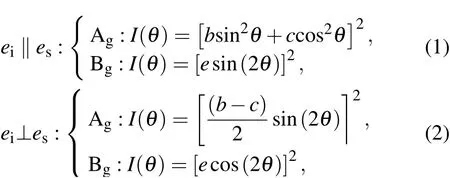
whereθis def ined as the angle between eiand the Y axis.From Eqs.(1)and(2),we f ind thatwhenθ=0,theAgphonon only appears under parallel polarization and the Bgphonon only appears under cross polarization;whenθ=π/4,the Agphonon appears under both parallel and cross polarizations,while the Bgphonon only appearsunderparallelpolarization.
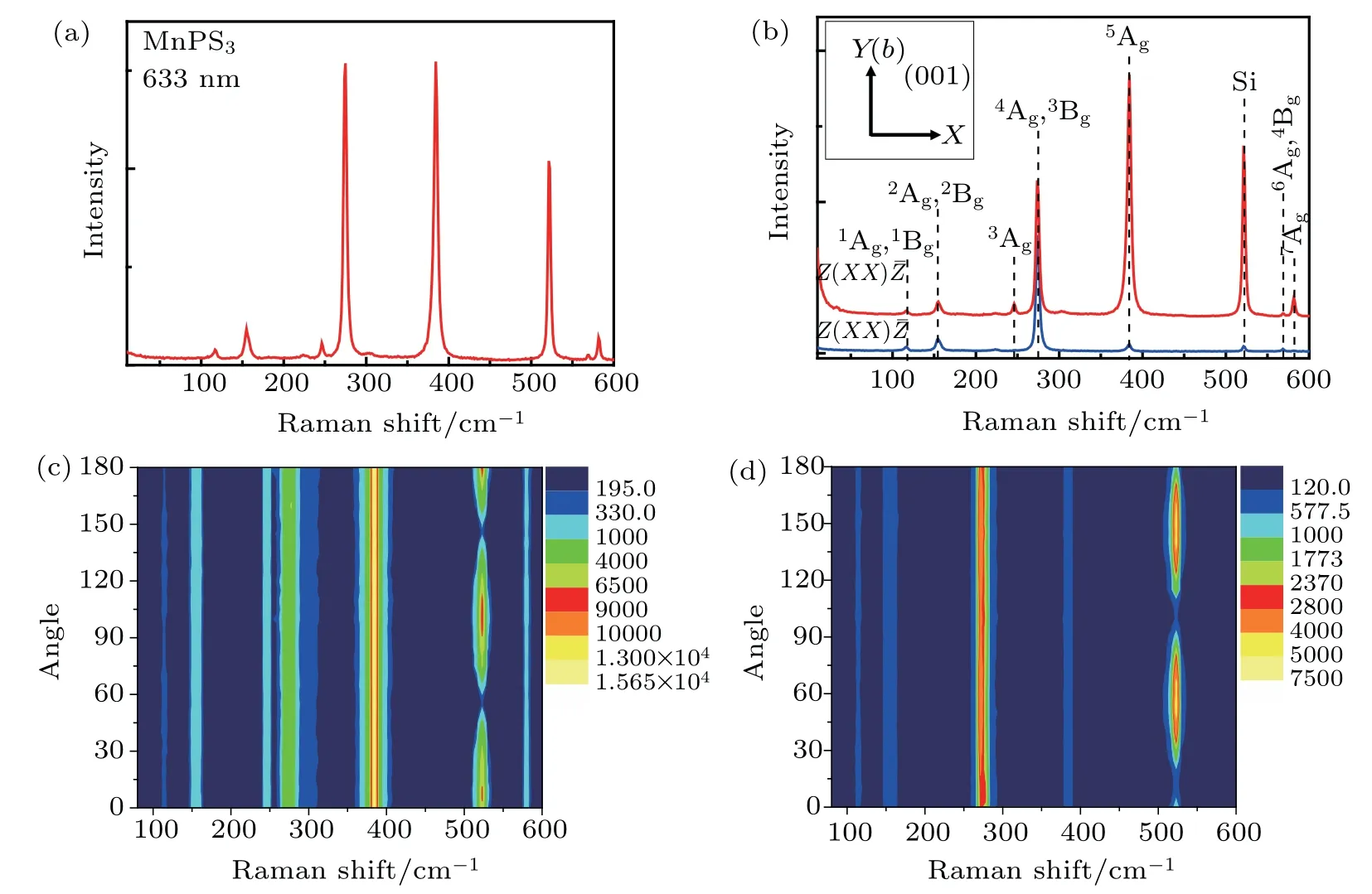
Fig.1.(a)Unpolarized Raman spectrum ofMnPS3 collected at room temperature.(b)Polarized Raman spectra ofMnPS3 at room temperature under Z(XX)ˉZ(red line)and Z(XY)ˉZ(blue line)scattering geometry.Inset:the XYZ/abc coordinates.(c)Intensitymap of Raman spectra of MnPS3 under parallelpolarization scattering geometry asa function of Raman shiftand angle.(d)Sameas(c),butunder crosspolarization geometry.
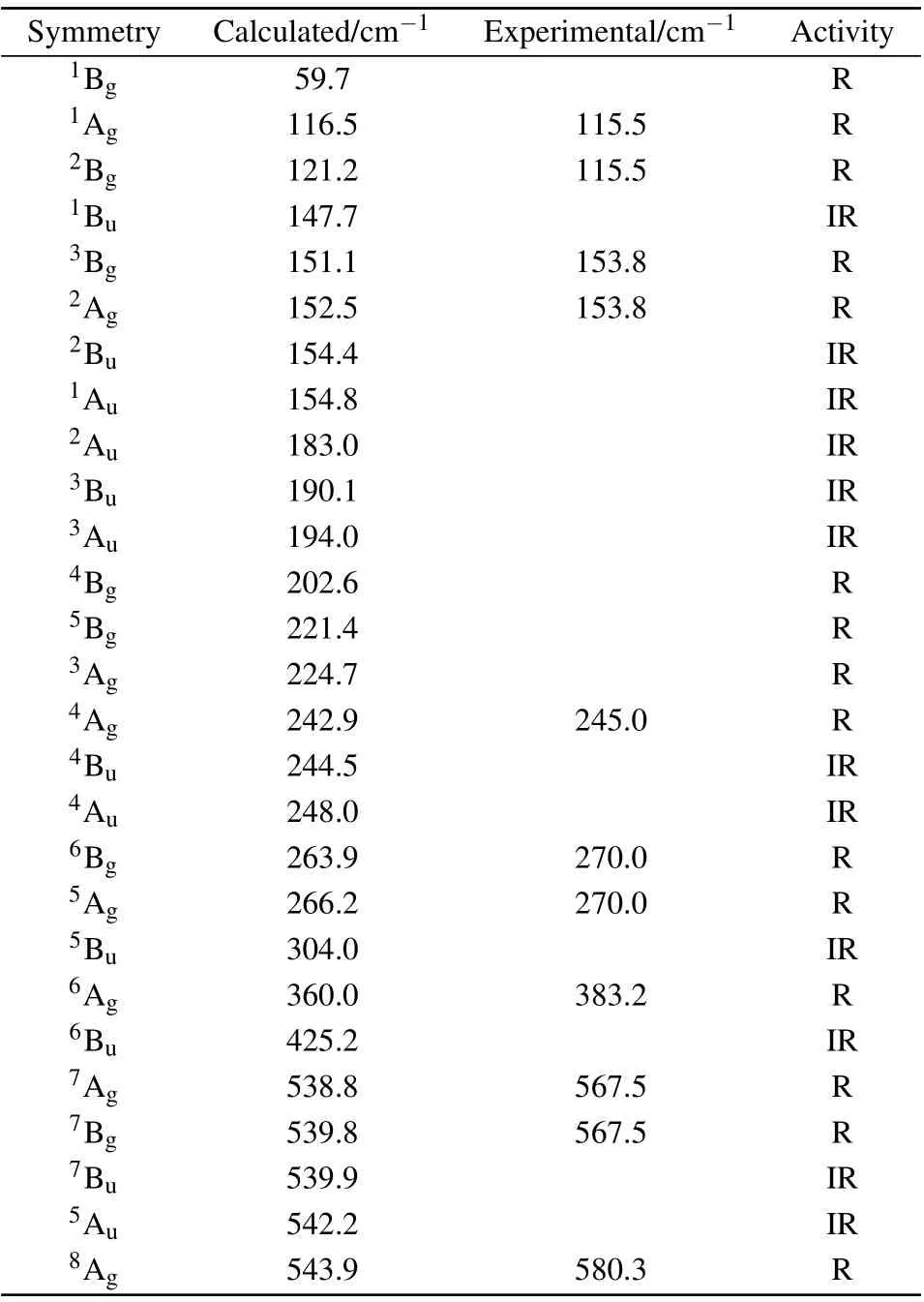
Table1.Calculated and experimentalopticalphononmodes(in cm-1)forMnPS3.Theatom icmotionsof themodesarealsogiven(see Fig.4).R and IR denote Raman and infrared activities,respectively.
In Figs.1(a)and 1(b),we show Raman spectraofMnPS3at room temperature.The peak at520.7 cm-1is from the Si substrate.A ll the remaining peaksare the phononsofMnPS3.
We assign the three MnPS3phonons that only appear in XX polarization to Agmode.However,no phonon modes only appear in the XY scattering geometry.In Figs.1(c)and 1(d),we track the angular dependence of the phonon intensity under parallel and cross polarizations.Surprisingly,we do not observe anymode that reduces to zero intensity atθ=π/4.
To f ind the origin of the remaining four phonon modes,we consider a change of the lattice symmetry in the 2D van derWaalsmaterials.Formonolayer MnPS3,the lattice point group is D3d.At theΓpoint,there are 3A1g+5EgRaman activemodes.The corresponding Raman tensorsare In this case,the 3A1gphonons show maximum intensity under XX polarization conf iguration and zero intensity under XY polarization conf iguration,while the intensity of the 5Egphononsdoesnotshow strong angulardependence.
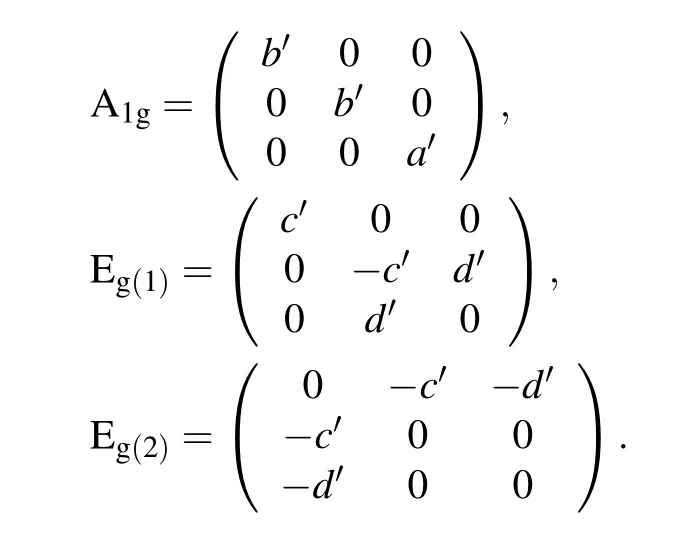
The bulk crystals consistof ABC-stacked single layer assemblies thatareheld togetherby van derWaals forces.Thus,forbulk crystals,theC3symmetry along the c axishasbroken compared to themonolayer crystals.Becauseof the symmetry breaking,the Egmode in D3dsymmetry w ill degenerate into Agand Bgmodeswhich have similarenergies in C2hsymmetry.Based on the discussion above,forMnPS3,the observed phononsare:115.5 cm-1(1Ag,1Bg),153.8 cm-1(2Ag,2Bg),245.0 cm-1(3Ag),270.0 cm-1(4Ag,3Bg),383.2 cm-1(5Ag),567.5 cm-1(6Ag,4Bg),and 580.3 cm-1(7Ag).
To relate theobservedmodesatcertain frequencies to the specif ic atomic displacements,we conduct the f irst-principles calculations.The experimentaland calculatedmode frequencies are summarized in Table 1.The calculated phonon frequenciesare in good agreementwith theexperimentaldata.In Fig.2,we show theatomic displacementsof allof the Raman activemodes.
Using the same analysismethod for MnPS3,we determ ine the phononmodes for FePS3and NiPS3.As shown in Fig.3(a),for FePS3,the observed phonons are:94.9 cm-1(1Ag,1Bg),156.9 cm-1(2Ag,2Bg),223.3 cm-1(3Ag,3Bg),245.8 cm-1(4Ag),275.2 cm-1(5Ag,4Bg),380.9 cm-1(6Ag),and 582.9 cm-1(7Ag).Near275.2 cm-1,thepeak energiesare slightly differentunder Z(XX)ˉZ and Z(XY)ˉZ scatteringgeometry,which suggests that thereare two differentmodesatvery close energy.The splitting of the peak is found at low temperatures,indicating that thesymmetry ofbulk crystals isC2h.The obvious difference between the two channels of FePS3at room temperature may be due to the different evolution of different phonon peakswith temperature.The NiPS3Raman spectra are shown in Fig.4,where the observed phonon modes are:132.2 cm-1(1Ag,1Bg),177.4 cm-1(2Ag,2Bg),234.8 cm-1(3Ag,3Bg),255.1 cm-1(4Ag),280.7 cm-1(5Ag,4Bg),384.8 cm-1(6Ag),and 589.2 cm-1(7Ag).The experimental resultsof FePS3and NiPS3are ingood agreementwith the theoretical calculations.[6]
In Fig.5,we show the Raman spectra in M PS3(M=Mn,Fe,Ni)at 10 K,TN,and 300 K.For all of the samples,we observe that the phononmode(~260 cm-1at300 K)splits into two peaks at the lowest temperature.We attribute this to the narrow ing of the phonon linew idth at low temperature.Moreover,we observe two unusual temperature-dependent behaviors for M PS3(M=Mn,Fe,Ni).Firstly,for FePS3,three new phononmodes appear in themagnetic order phase(T<TN),while we do not observe such additionalmodes in MnPS3or NiPS3.This different behavior in FePS3must be related to its specialmagnetic structure.We attribute this to the AF interlayermagnetic structure in FePS3,which doubles the lattice unit cell if there is a strong spin–lattice coupling,
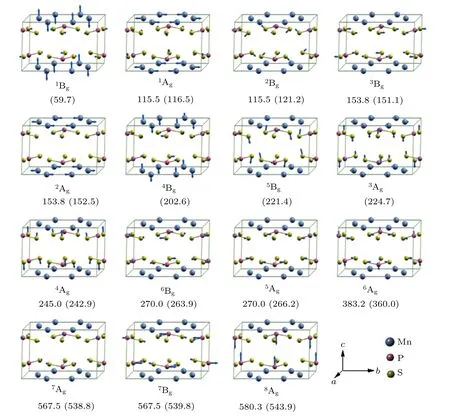
Fig.2.Vibration patternsofallRamanmodesobserved in MnPS3.Themodesymmetry,opticalactivity,and experimental(calculated)phonon frequency(theunitis cm-1)arealso listed below each pattern.
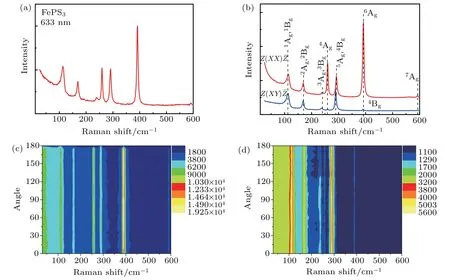
Fig.3.(a)Raman spectrum of FePS3 collected at room temperature.(b)Polarized Raman spectrum of FePS3 at room temperature under different polarization conf igurations.(c)The angle-dependent Raman spectrum of FePS3 in parallel polarization channel.(d)The angledependentRaman spectrum of FePS3 in cross polarization channel.
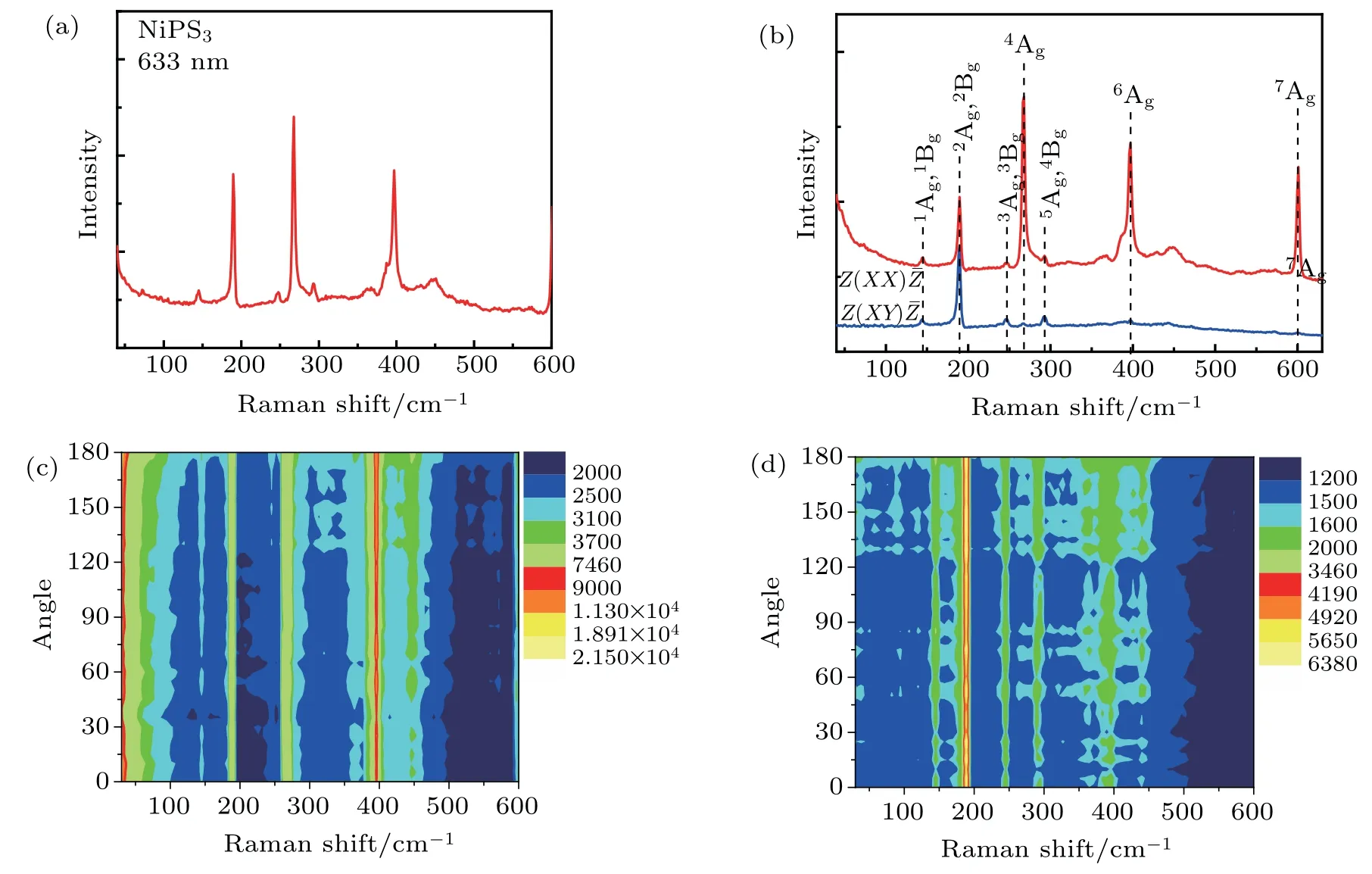
Fig.4.(a)Unpolarized Raman spectrum of NiPS3 at room temperature.(b)Polarized Raman spectrum of NiPS3 at room temperature under different polarization conf igurations.(c)The angle-dependent Raman spectrum of NiPS3 in parallel polarization channel.(d)The angle-dependentRaman spectrum of NiPS3 in crosspolarization channel.
and,consequently,the zoneboundarymodesare folded to the Γpoint.In Mn/NiPS3,the interlayermagnetic structure is FM,and w illnotdouble the lattice unitcell.Thisexplains the non-observation of additionalmodes in Mn/NiPS3.Secondly,forMnPS3and NiPS3,they have the same out-of-planemagnetism but different in-planemagnetism.The in-planemagnetism is zig-zag type AF in NiPS3,while the in-planemagnetism is N′eel type AF in MnPS3.We f ind that the energy of the 150 cm-1phononmode at10 K ismuch lower than that at 300 K in MnPS3,which is unusual for a normal phonon mode.The lower energy of thismode at 10 K indicates its coupling with spins,whichmodulates the self-energy of this phonon and causes the lower energy of it.This indicates that the in-planeN′eelAF inMnPS3favorsaspin–phonon coupling compared to the in-plane zig-zag AF in NiPS3and FePS3.Comparing the ab in-plane and the c axis out-of-planemagnetic structureof the series,it is found thatspin–phonon coupling isgeneral in this fam ilymaterialsand differentmagnetic structuresw ill have different inf luences on the phonons and magnons.
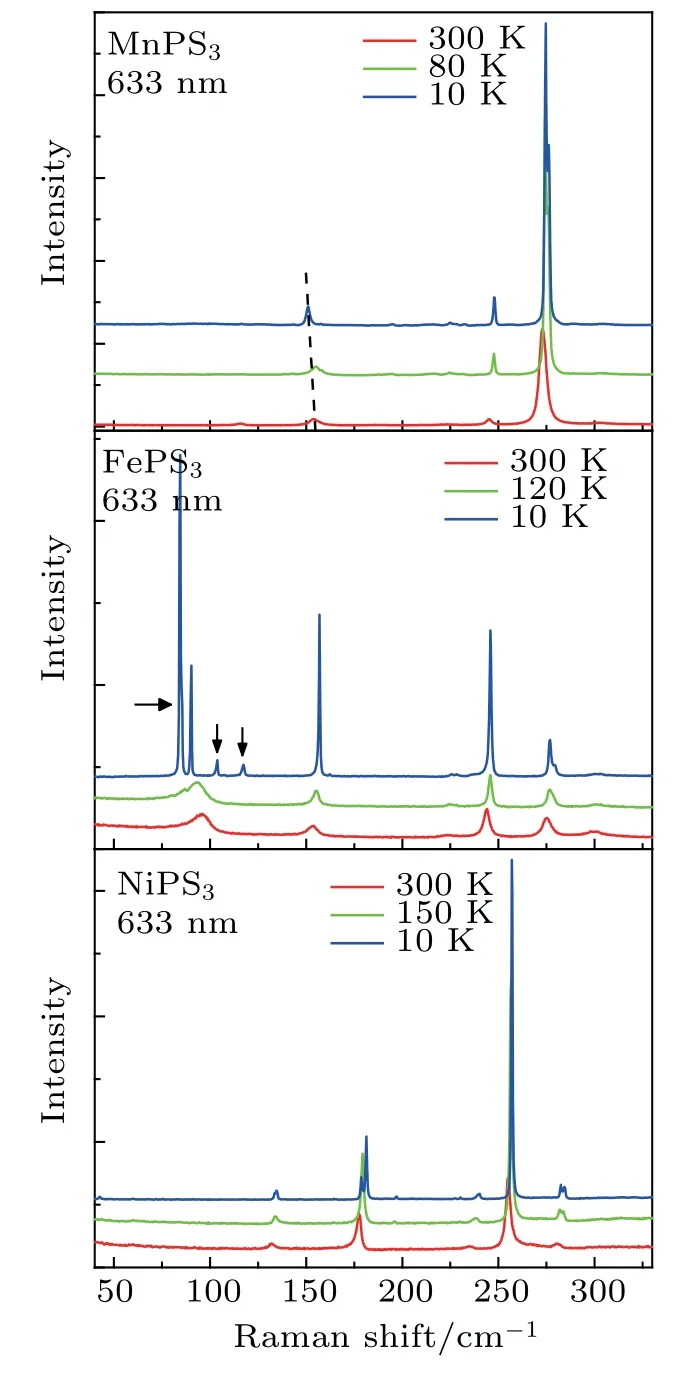
Fig.5.The temperature dependence of Raman spectra of MnPS3,FePS3,and NiPS3.The dashed line indicates the softened mode in MnPS3 and thearrows indicate thenew modes in FePS3 below T N.
4.Conclusion and perspectives
We report the experimental and f irst-principles calculation for the temperature dependentand polarization resolved Raman spectroscopy on the lattice dynamics of M PS3(M=Mn,Fe,Ni)single crystals.We identify 7 outof11Raman active phonons and the corresponding atom ic displacements.In addition,we observe additional phonons appearing in FePS3in themagnetic ordered state,while there is no new phonon mode in MnPS3and NiPS3.Thismagneto-elastic effect is related to uniqueAForderalong the c axisin FePS3,which doubles the unit celland folds the zone boundarymode to theΓ point.ForMnPS3,partof the phononsare softened below TN,suggesting spin–phonon coupling in thismaterial.Thepresent study provides the system information on the latticedynamics andmagneticof M PS3(M=Mn,Fe,Ni)and isof signif icance for theexploration of structuralandmagnetic propertiesof the monolayer M P X3.
Acknow ledgments
Computational resourceshavebeen provided by thePhysical Laboratory of High Performance Computing at Renmin University of China.The atom ic structures and vibrational displacement patterns were prepared with the XCRYSDEN program.[33]
- Chinese Physics B的其它文章
- Computational study of inverse ferrite spinels
- Effectsof chem icalpressure on dilutedmagnetic sem iconductor(Ba,K)(Zn,M n)2As2*
- Particle–hole f luctuationsand possible superconductivity in dopedα-RuCl3*
- Surface stabilized cubic phaseof CsPb I3 and CsPbBr3 atroom tem perature*
- Low tem perature Pmmm and C2/m phases in Sr2CuO3+δ high temperature superconductor*
- Crystallographic andmagnetic propertiesof van derWaals layered FePS3 crystal*

